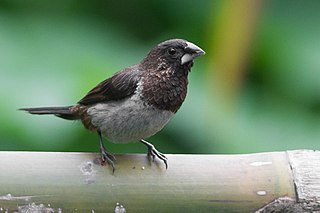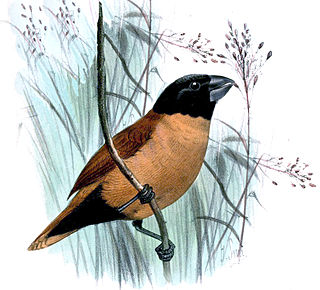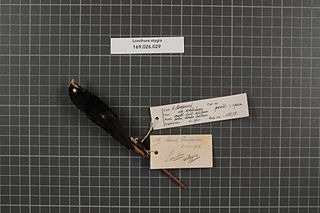
The bronze mannikin or bronze munia is a small passerine bird of the Afrotropics. This very social estrildid finch is an uncommon to locally abundant bird in much of Africa south of the Sahara Desert, where it is resident, nomadic or irruptive in mesic savanna or forest margin habitats. It has an estimated global extent of occurrence of 8,100,000 km2. It is the smallest and most widespread of four munia species on the African mainland, the other being black-and-white, red-backed and magpie mannikin. It co-occurs with the Madagascar mannikin on the Comoro Islands, and was introduced to Puerto Rico. Especially in the West Africa, it is considered a pest in grain and rice fields. It is locally trapped for the pet bird trade.

The white-rumped munia or white-rumped mannikin, sometimes called striated finch in aviculture, is a small passerine bird from the family of waxbill "finches" (Estrildidae). These are not close relatives of the true finches (Fringillidae) or true sparrows (Passeridae).

The black-throated munia or Jerdon's mannikin is a small passerine bird. This estrildid finch is a resident breeding bird in the hills of southwest India, the Western Ghats, Eastern Ghats and Sri Lanka.

The scaly-breasted munia or spotted munia, known in the pet trade as nutmeg mannikin or spice finch, is a sparrow-sized estrildid finch native to tropical Asia. A species of the genus Lonchura, it was formally described and named by Carl Linnaeus in 1758. Its name is based on the distinct scale-like feather markings on the breast and belly. The adult is brown above and has a dark conical bill. The species has 11 subspecies across its range, which differ slightly in size and color.

The chestnut munia or black-headed munia is a small passerine. It was formerly considered conspecific with the closely related tricoloured munia, but is now widely recognized as a separate species. This estrildid finch is a resident breeding bird in Bangladesh, Brunei, Cambodia, China, India, Indonesia, Laos, Malaysia, Burma, Nepal, the Philippines, Singapore, Taiwan, Thailand, Vietnam and Hawaii. It also has been introduced to all the Greater Antilles and Martinique in the Caribbean.

Lonchura is a genus of the estrildid finch family, and includes munias and mannikins. They are seed-eating birds that are found in South Asia from India, Bangladesh, Sri Lanka east to Indonesia, Papua New Guinea, and the Philippines. The name mannikin is from Middle Dutch mannekijn 'little man'.

The streak-headed mannikin also known as the streak-headed munia, is a small 10 cm (3.9 in) long estrildid finch.

The dusky munia is a species of estrildid finch which is endemic to Borneo. It is also commonly referred to as the Dusky mannikin and the Bornean munia. It is in the family of perching birds (Passeriformes) and is in the genus Lonchura. It is a monotypic species, and there are no subspecies in the genus.
The western alpine mannikin also known as Snow Mountain mannikin or western alpine munia is a small, approximately 11.5 cm long, estrildid finch. Both sexes are similar with dark brown plumage, black face, buff chest and black-barred white abdomen. The young has black bill, dark brown plumage and buffy-white below.

The hooded mannikin or hooded munia, also known as the New Britain mannikin or Sclater's mannikin, is a species of estrildid finch found in New Britain and New Guinea.

Mottled mannikin or mottled munia is a species of estrildid finch breeding in New Ireland. This species is also introduced to Pohnpei. It has an estimated global extent of occurrence of 20,000 to 50,000 km2. It is found in subtropical/ tropical (lowland) dry grassland habitat. The New Hanover mannikin has sometimes been treated as a subspecies of mottled mannikin with the name Hunstein's mannikin for the combined taxa. The status of mottled mannikin is evaluated as Least Concern. The males are similarly colored to the extinct Hawaiian ʻUla ʻAi Hāwane, a Hawaiian honeycreeper.

Forbes's mannikin or the New Ireland munia, is a species of estrildid finch breeding in Papua New Guinea. It has an estimated global extent of occurrence of 20,000 to 50,000 km2. It is found in subtropical or tropical lowland dry grassland habitat. The status of the species is evaluated as Least Concern.

The chestnut-breasted mannikin, also known as the chestnut-breasted munia or bully bird, is a small brown-backed munia with a black face and greyish crown and nape. It has a broad ferruginous breast bar above a white belly. The species is found in Australia, New Caledonia, Indonesia, and Papua New Guinea. This species has also been introduced to French Polynesia.

The black mannikin or black munia is a species of estrildid finch found in New Guinea, from Mandum to Lake Daviumbu, Papua New Guinea. It is commonly found in flocks of maximum 20 birds, inhabiting savannas, wetlands, but sometimes they were also seen at rice crops.

The black-breasted mannikin or black-breasted munia is a species of estrildid finch endemic to West Papua, Indonesia. It has an estimated global extent of occurrence of 20,000 to 50,000 km2. It is found in subtropical/ tropical lowland dry shrubland and high altitude grassland habitat. The status of the species is Least Concern.
The eastern alpine mannikin or alpine munia, is a species of estrildid finch native to the Papuan Peninsula. It has an estimated global extent of occurrence of 20,000 to 50,000 km2.

The tricoloured munia is an estrildid finch, native to Bangladesh, India, Sri Lanka, Pakistan, and southern China. The species has also introduced to the Caribbean, in Trinidad, Jamaica, Hispaniola, Puerto Rico, Cuba, and Venezuela. This species, like the chestnut munia has been known as the black-headed munia. Immature birds have pale brown upperparts, lack the dark head found in adults, and have uniform buff underparts that can be confused with immatures of other munias such as the scaly-breasted munia.

The pictorella mannikin, pictorella munia, or pictorella finch is small brown and grey finch with a grey bill and distinctive scaly white breast plate which is endemic to northern Australia. It is a seed-eater found in pairs and small flocks in dry savannah and subtropical or tropical dry lowland grassland.

The Vogelkop montane rain forests is a tropical moist forest ecoregion in western New Guinea. The ecoregion covers the mountains of western New Guinea's Bird's Head and Bomberai peninsulas.


















